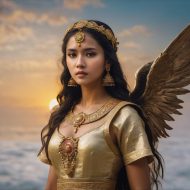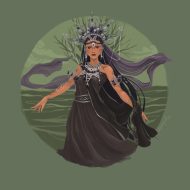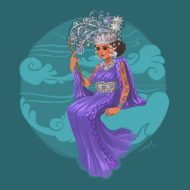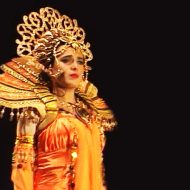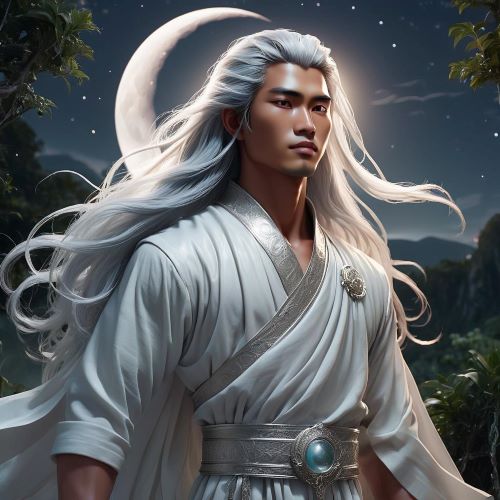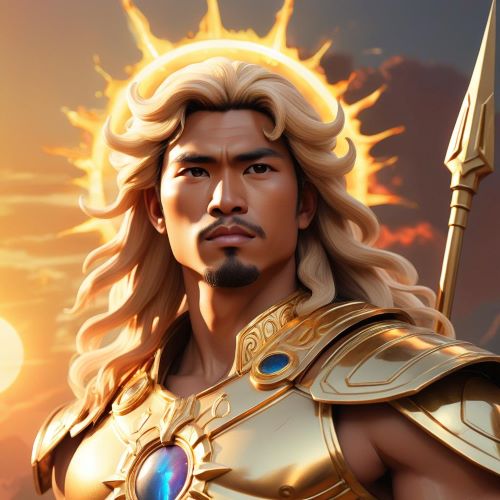Launsina : The Moon Goddess
Listen
At a glance
| Description | |
|---|---|
| Origin | Philippine Mythology |
| Classification | Gods |
| Family Members | Tungkung Langit (Husband), Datu Paubari (Husband) |
| Region | Philippines |
| Associated With | Moon, Fertility, Eastern Skies |
Lausina
Introduction
Launsina, a lesser-known but fascinating deity who holds a special place in Filipino mythology. Launsina is the goddess of the harvest, revered by indigenous communities for her role in ensuring bountiful crops and the well-being of farmers. According to the Capiznon people of the Philippines, Launsina is the goddess of the sun, moon, stars, and seas and is the most beloved by people. Launsina is celebrated through various cultural festivals and rituals in different regions of the Philippines. These celebrations are a vibrant display of indigenous culture and a testament to the enduring legacy of the goddess.
Physical Traits
Launsina is often depicted as a beautiful woman adorned with traditional Filipino attire, typically wearing a colorful saya (a traditional dress) and holding a kakanin (rice cake), a symbol of harvest and abundance. Her image radiates warmth, serenity, and maternal care, embodying the nurturing aspects associated with a deity responsible for the fertility of the land.
One of her most striking attributes is her long, flowing hair, which symbolizes the fertile soil and the life-giving waters that are essential for a bountiful harvest. It is believed that Launsina’s hair has the power to heal and rejuvenate the land, making her a figure of reverence among farmers.
Family
Launsina’s origins trace back to the pre-colonial history of the Philippines, where she emerges as a prominent figure in the Tagalog pantheon, which represents one of the country’s major ethnic groups. The Tagalog people primarily inhabit the central region of the Philippines, particularly in the area known today as Luzon. Although the details of Launsina’s story remain scant in Philippine mythology, her significance is undeniable. She is believed to have played a pivotal role in the creation of the world. According to one legend, Bathala, the supreme god of Tagalog mythology, dispatched Launsina with a golden egg containing all the essential elements for fashioning the universe. Launsina cracked open the egg and utilized its contents to craft every facet of the cosmos.
In the Visayan epic poem “Hinilawod,” originating from the Suludnon tribe of Panay, Alunsina takes on the role of the virgin goddess. She is believed to have descended from Kaptan, who was Lihangin’s sister born after his passing. The Sky God, deeply protective of Alunsina’s purity, shielded her from prying eyes until she reached maturity. Many deities vied for the affection of this resplendent goddess, with the most ardent suitor being Maklium-sa-t’wan, the earthly god of the plains. Nevertheless, Alunsina’s heart was captured by a human named Datu Paubari, whom she chose as her husband.
Other names
In a variation of the Creation Myth originating from Panay Island in the Visayas, Alunsina’s name carries various translations, including “The Unmarried One,” “The One from Distant Skies,” and “The Foreign One.” These interpretations underscore her status as a celestial deity, portraying her as a foreigner who descended from the eastern or, in some accounts, the northern heavens before the world’s creation.
The name “Launsina” itself presents an intriguing linguistic amalgamation, merging “lunas,” signifying “cure” or “healing,” with “sina,” an honorific prefix. This nomenclature beautifully encapsulates the goddess’s pivotal role in safeguarding the well-being of both the land and its inhabitants. Her association with healing hints at an influence that transcends agriculture, encompassing the realm of human health and vitality.
Powers and Abilities
She was revered as the goddess of the eastern skies, responsible for ushering in the sun’s light and refreshing breezes during the scorching days of the dry season. Moreover, she held the title of protector against fierce typhoons and was associated with matters of beauty and marriage. It was widely believed that she served as the patron goddess for various groups, including single women, virgins, lovers, housewives, and brides.
Young girls on the cusp of womanhood, in particular, held Alunsina in high regard due to her role as a virgin goddess before her marriage. They prayed to her, seeking guidance in finding the ideal life partner when they reached the age of matrimony. Among ancient Ilonggo housewives, Alunsina represented marital fidelity and served as a guardian against clandestine affairs.
Wives offered prayers to her, imploring that she would ensure their husbands remained faithful and refrained from secretive liaisons with other women. An age-old belief persisted among Ilonggo farmers, suggesting that when a wife fed her husband’s beast of burden, often a carabao, with grass blessed in Alunsina’s name by the babaylan, the creature would lead the wife to the clandestine hideaway where her husband and his secret lover had established their rendezvous.
Modern Day Influence
Alunsina’s prominence waned upon the arrival of the Spanish in Panay Island, as her worship and reverence gave way to the adoration of the Holy Mother Mary among Catholic Christians, leading to the conversion of many Panayanons to the new faith. Nevertheless, in contrast to most deities from the Visayan pantheon, her renown and veneration did not completely fade away.
Some Sulodnon communities residing in the untouched mountain regions, far removed from modern civilization and religious reforms, have diligently upheld their cultural traditions and customs. Consequently, Alunsina’s legacy was not only preserved through ancient myths but also within the pantheon revered by Sulodnon families on Panay Island, who persist in safeguarding their heritage against the influences of modernism and Westernization to this day.
Related Images
Frequently Asked Questions
What is lorem Ipsum?
I am text block. Click edit button to change this text. Lorem ipsum dolor sit amet, consectetur adipiscing elit. Ut elit tellus, luctus nec ullamcorper mattis, pulvinar dapibus leo.
What is lorem Ipsum?
I am text block. Click edit button to change this text. Lorem ipsum dolor sit amet, consectetur adipiscing elit. Ut elit tellus, luctus nec ullamcorper mattis, pulvinar dapibus leo.
What is lorem Ipsum?
I am text block. Click edit button to change this text. Lorem ipsum dolor sit amet, consectetur adipiscing elit. Ut elit tellus, luctus nec ullamcorper mattis, pulvinar dapibus leo.
What is lorem Ipsum?
I am text block. Click edit button to change this text. Lorem ipsum dolor sit amet, consectetur adipiscing elit. Ut elit tellus, luctus nec ullamcorper mattis, pulvinar dapibus leo.
What is lorem Ipsum?
I am text block. Click edit button to change this text. Lorem ipsum dolor sit amet, consectetur adipiscing elit. Ut elit tellus, luctus nec ullamcorper mattis, pulvinar dapibus leo.

